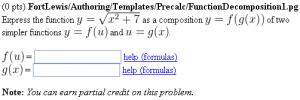Difference between revisions of "FunctionDecomposition1"
Jump to navigation
Jump to search
Paultpearson (talk | contribs) |
Paultpearson (talk | contribs) (PGML example link) |
||
| Line 6: | Line 6: | ||
</p> |
</p> |
||
* File location in OPL: [https://github.com/openwebwork/webwork-open-problem-library/blob/master/OpenProblemLibrary/FortLewis/Authoring/Templates/Precalc/FunctionDecomposition1.pg FortLewis/Authoring/Templates/Precalc/FunctionDecomposition1.pg] |
* File location in OPL: [https://github.com/openwebwork/webwork-open-problem-library/blob/master/OpenProblemLibrary/FortLewis/Authoring/Templates/Precalc/FunctionDecomposition1.pg FortLewis/Authoring/Templates/Precalc/FunctionDecomposition1.pg] |
||
| + | * PGML location in OPL: [https://github.com/openwebwork/webwork-open-problem-library/blob/master/OpenProblemLibrary/FortLewis/Authoring/Templates/Precalc/FunctionDecomposition1_PGML.pg FortLewis/Authoring/Templates/Precalc/FunctionDecomposition1_PGML.pg] |
||
Revision as of 20:47, 13 June 2015
Function Decomposition
This PG code shows how to check student answers that are a composition of functions.
- File location in OPL: FortLewis/Authoring/Templates/Precalc/FunctionDecomposition1.pg
- PGML location in OPL: FortLewis/Authoring/Templates/Precalc/FunctionDecomposition1_PGML.pg
| PG problem file | Explanation |
|---|---|
|
Problem tagging: |
|
DOCUMENT(); loadMacros( "PGstandard.pl", "MathObjects.pl", "answerComposition.pl", "AnswerFormatHelp.pl", ); TEXT(beginproblem()); |
Initialization:
We need to include the macros file |
Context("Numeric");
Context()->variables->add(u=>"Real");
$a = random(2,9,1);
$f = Formula("sqrt(u)");
$g = Formula("x^2+$a");
|
Setup: |
Context()->texStrings;
BEGIN_TEXT
Express the function \( y = \sqrt{ x^2 + $a } \)
as a composition \( y = f(g(x)) \) of two simpler
functions \( y = f(u) \) and \( u = g(x) \).
$BR
$BR
\( f(u) \) = \{ ans_rule(20) \}
\{ AnswerFormatHelp("formulas") \}
$BR
\( g(x) \) = \{ ans_rule(20) \}
\{ AnswerFormatHelp("formulas") \}
END_TEXT
Context()->normalStrings;
|
Main Text: |
$showPartialCorrectAnswers = 1; COMPOSITION_ANS( $f, $g, vars=>['u','x'], showVariableHints=>1); |
Answer Evaluation:
We use the |
Context()->texStrings;
BEGIN_SOLUTION
${PAR}SOLUTION:${PAR}
Solution explanation goes here.
END_SOLUTION
Context()->normalStrings;
COMMENT('MathObject version.');
ENDDOCUMENT();
|
Solution: |
